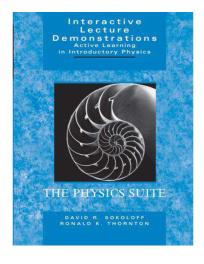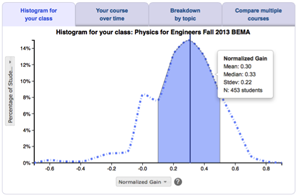
Developed by: David Sokoloff and Ron Thornton


middle schoolhigh schoolintro collegeinter-mediateupper levelgrad school other

calc based

alg based







Overview
What? Worksheets for use in lecture. Students predict results of demos, discuss in small groups, observe results, compare with predictions and explain. Designed for use with Microcomputer-Based Laboratory (MBL) equipment. Adaptable for use with simulations.
Why? ILDs are an easy way to add interactivity to in-class demonstrations and connect them with students' prior experiences. Student discussions of unexpected "dissonant moments" can elicit rich sense-making discussions. ILDs have been shown to increase in students' appreciation of big ideas in physics.
Why not? ILDs can be expensive, both for departments that need to purchase the equipment, and for students who need to purchase the books of activities. Free-access ILDs are available online, but often lack the support of the commercially published materials.
Classroom video
Activity outline
The Eight Step Interactive Lecture Demonstration Procedure
1. Describe the demonstration and do it for the class without MBL measurements.
2. Ask students to record individual predictions.
3. Have the class engage in small group discussions with nearest neighbors.
4. Ask each student to record final prediction on handout sheet (which will be collected).
5. Elicit predictions & reasoning from students.
6. Carry out the demonstration with MBL measurements displayed.
7. Ask a few students to describe the result. Then discuss results in the context of the demonstration. Ask students to fill out “results sheet” (which they keep).
8. Discuss analogous physical situations with different "surface" features. (That is, a different physical situation that is based on the same concept.)
Topic outline
Section I: Introduction to Interactive Lecture Demonstrations
The Eight Step Interactive Lecture Demonstration Procedure
Section II: Interactive Lecture Demonstrations in Mechanics
KIN1 Kinematics 1--Human Motion
KIN2 Kinematics 2--Motion of Carts
N1&2 Newton's 1st & 2nd Laws
N3 Newton's 3rd Law
VECT Vectors
PROJ Projectile Motion
ENER Energy of a Cart on a Ramp
MOM Momentum
ROTM Rotational Motion
STAT Statics
FLUS Fluid Statics
Section III: Interactive Lecture Demonstrations in Oscillations and Waves
SHM Simple Harmonic Motion
SND Sound
Section IV: Interactive Lecture Demonstrations in Heat and Thermodynamics
INHT Introduction to Heat and Temperature
SPHT Specific Heat
HTPC Heat and Phase Changes
HENG Heat Engine
Section V: Interactive Lecture Demonstrations in Electricity and Magnetism
EFFP Electrostatic Field, Force and Potential
INDC Introduction to DC Circuits
SPC Series and Parallel Circuits
RCC RC Circuits
MAG Magnetism
EMIN Electromagnetic Induction
ACC AC Circuits
Section VI: Interactive Lecture Demonstrations in Light and Optics
RRLT Reflection and Refraction of Light
IMFL Image Formation with Lenses
MIRR Mirrors
POL Polarized Light
Student skills developed
- Conceptual understanding
- Using multiple representations
Instructor effort required
- Low
Resources required
- Cost for students
Resources
Guide: SERC Guide to ILDs
Overview:
Interactive Lecture Demonstrations, in E. F. Redish, Teaching Physics with the Physics Suite (2003), pp. 135-137.
Workshops:
The developers of ILDs regularly offer in-person workshops, with dates regularly updated on their website.
Teaching Materials
You can download the full set of ILDs for free or buy the full set of ILDs from Wiley.
In response to COVID-19, the developers have created Home Adapted Interactive Lecture Demonstrations.
The University of Maryland has also developed their own free set of ILDs.
Research
This is the third highest level of research validation, corresponding to:
- at least 1 of the "based on" categories
- at least 1 of the "demonstrated to improve" categories
- at least 1 of the "studied using" categories
Research Validation Summary
Based on Research Into:
- theories of how students learn
- student ideas about specific topics
Demonstrated to Improve:
- conceptual understanding
- problem-solving skills
- lab skills
- beliefs and attitudes
- attendance
- retention of students
- success of underrepresented groups
- performance in subsequent classes
Studied using:
- cycle of research and redevelopment
- student interviews
- classroom observations
- analysis of written work
- research at multiple institutions
- research by multiple groups
- peer-reviewed publication
References
- S. Chaudhury, S. Canatsey, and P. Ward, A perspective on Interactive Lecture Demonstrations as a computer supported collaborative learning (CSCL) activity, J. Phys. Conf. Ser. 1287 (1), 012060 (2019).
- T. French and K. Cummings, Effectiveness of Abridged Interactive Lecture Demonstrations, presented at the Physics Education Research Conference 2002, Boise, Idaho, 2002.
- M. Sharma, I. Johnston, H. Johnston, K. Varvell, G. Robertson, A. Hopkins, C. Stewart, I. Cooper, and R. Thornton, Use of interactive lecture demonstrations: A ten year study, Phys. Rev. ST Phys. Educ. Res. 6 (2), 020119 (2010).
- D. Sokoloff and R. Thornton, Using interactive lecture demonstrations to create an active learning environment, Phys. Teach. 35 (6), 340 (1997).
- M. Wittmann, On the Dissemination of Proven Curriculum Materials: RealTime Physics and Interactive Lecture Demonstrations, 2002.





